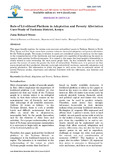| dc.description.abstract | This paper broadly explores the various socio-economic and political assets in Turkana District in North
West, Kenya and how these assets have overtime enhanced successful adaptation and poverty alleviation
for the Turkana people. Two issues in relation to assets are considered: access to assets as the key issue
in the conceptualization of the livelihoods, and local people’s own capability of transforming the assets to
improve their existing livelihood strategies. It is argued in this paper that local people’s vulnerability is
closely related to asset ownership: the more assets people have, the less vulnerable they are and the
greater the erosion of assets the greater the level of vulnerability. Furthermore, it is pointed out that
assets owned and their productive diversity is strongly related with resilience, successful adaptation and
poverty alleviation. The information in which this paper is built comes from an extensive review of
several Turkana studies, observation and informal Interviews with key informants, case histories and
mapping. | en_US |

